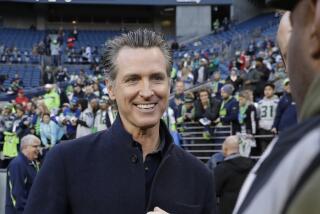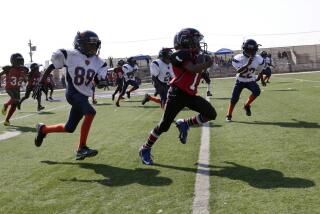Sports headache
For years, the NFL blithely denied that there were long-term health effects from multiple concussions. It took congressional pressure for professional football to acknowledge the problem and help fund a study, which found links between repeated concussions and depression and dementia later in life. Another study published this month found that multiple head traumas were associated with increased risk of a condition that mimics amyotrophic lateral sclerosis, or Lou Gehrig’s disease.
The NFL has been changing its practices to allow fuller recovery from concussion before a player plays again. More important, several states, including California, have placed similar restrictions on high school sports. There are a lot more high school athletes than professionals, and many researchers believe that concussions endanger the health of young brains more than adults’; all states should be adopting such rules.
As helpful as full healing is, though, it doesn’t solve the inherent problem of multiple concussions, usually defined as three or more. People who get one concussion are more likely to suffer another; researchers believe some people are more prone to the head injury. And none of the new rules addresses the unnerving discovery that even younger athletes — ages 8 to 13 — have increasingly shown up at emergency rooms with concussions.
According to a study published in the journal Pediatrics in August that examined U.S. emergency room visits from 1997 to 2007, the number of concussions related to the five most popular competitive youth sports more than doubled among this age group, even though participation in those sports declined slightly. Among 14- to 19-year-olds, the number of concussions tripled. Altogether, there were about 250,000 concussions among young competitive athletes.
The numbers might reflect parents and coaches seeking immediate medical attention for children’s head injuries. But researchers believe other factors are involved as well, such as longer, more intense playing seasons and practices. The youth soccer season, which used to comprise about three months of low-key play, has been extended by club teams, as well as soccer camps, to cover most of the year. And the games are more competitive.
More research is needed on the causes and long-term effects of concussion on children and teenagers. But youth athletic leagues, state health officials and schools should be taking action now. Lisa Bakhos, the lead researcher on the Pediatrics study, suggests a return to more varied sports activities for children, played more for fun and less as structured competition. Youth league rules should be modified to reduce blows to the head, and parents should be informed about concussion risks from the start. Parents of a child who sustains two concussions should be counseled to consider whether it might be time for a switch to a sport such as running, with less potential for head injury.






